Abstract
The cell surface hydrophobicities of a variety of aquatic and terrestrial gliding bacteria were measured by an assay of bacterial adherence to hydrocarbons (BATH), hydrophobic interaction chromatography, and the salt aggregation test. The bacteria demonstrated a broad range of hydrophobicities. Results among the three hydrophobicity assays performed on very hydrophilic strains were quite consistent. Bacterial adhesion to glass did not correlate with any particular measure of surface hydrophobicity. Several adhesion-defective mutants of Cytophaga sp. strain U67 were found to be more hydrophilic than the wild type, particularly by the BATH assay and hydrophobic interaction chromatography. The very limited adhesion of these mutants correlated well with hydrophilicity as determined by the BATH assay. The hydrophobicities of several adhesion-competent revertants ranged between those of the wild type and the mutants. As measured by the BATH assay, starvation increased hydrophobicity of both the wild type and an adhesion-defective mutant. During filament fragmentation of Flexibacter sp. strain FS-1, marked changes in hydrophobicity and adhesion were accompanied by changes in the arrays of surface-exposed proteins as detected by an immobilized radioiodination procedure.
Full text
PDF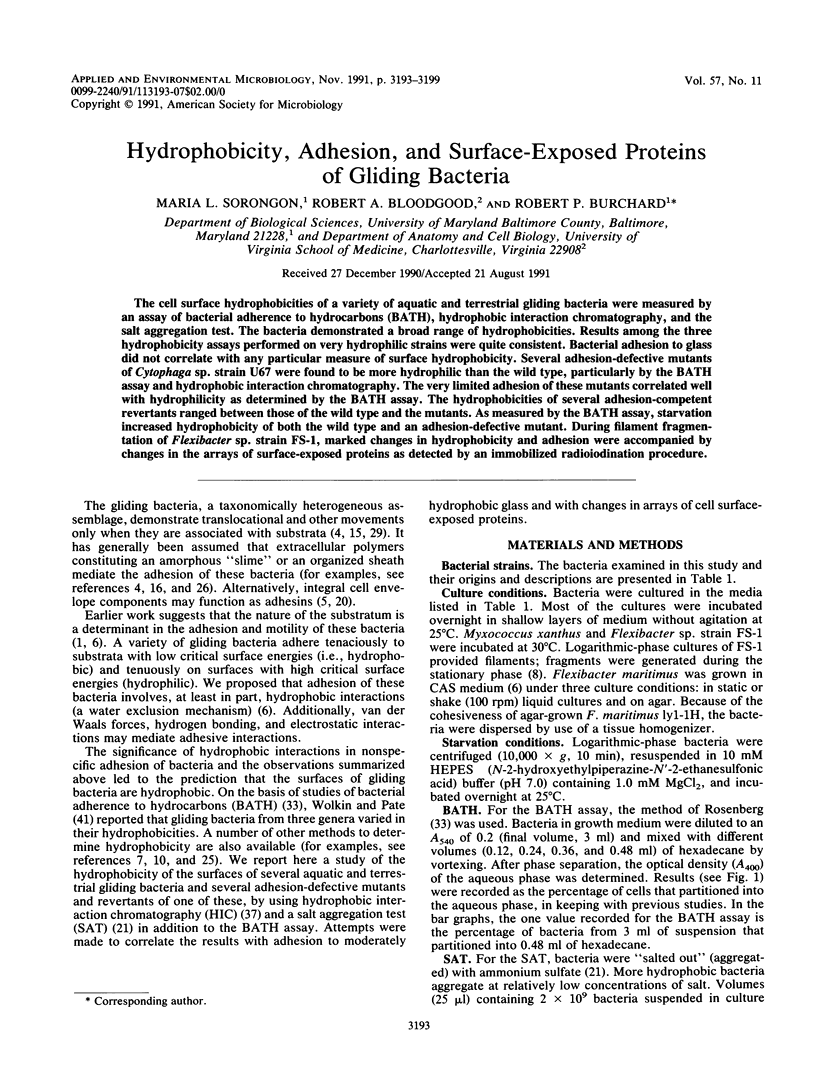
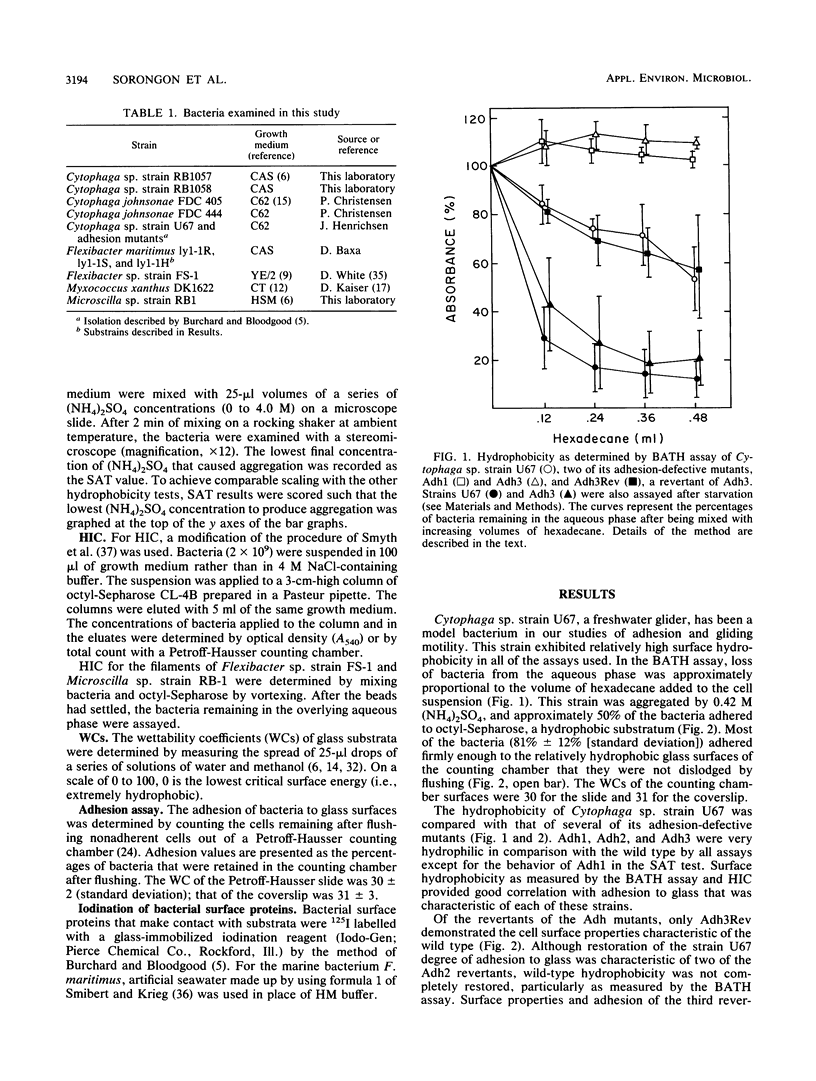
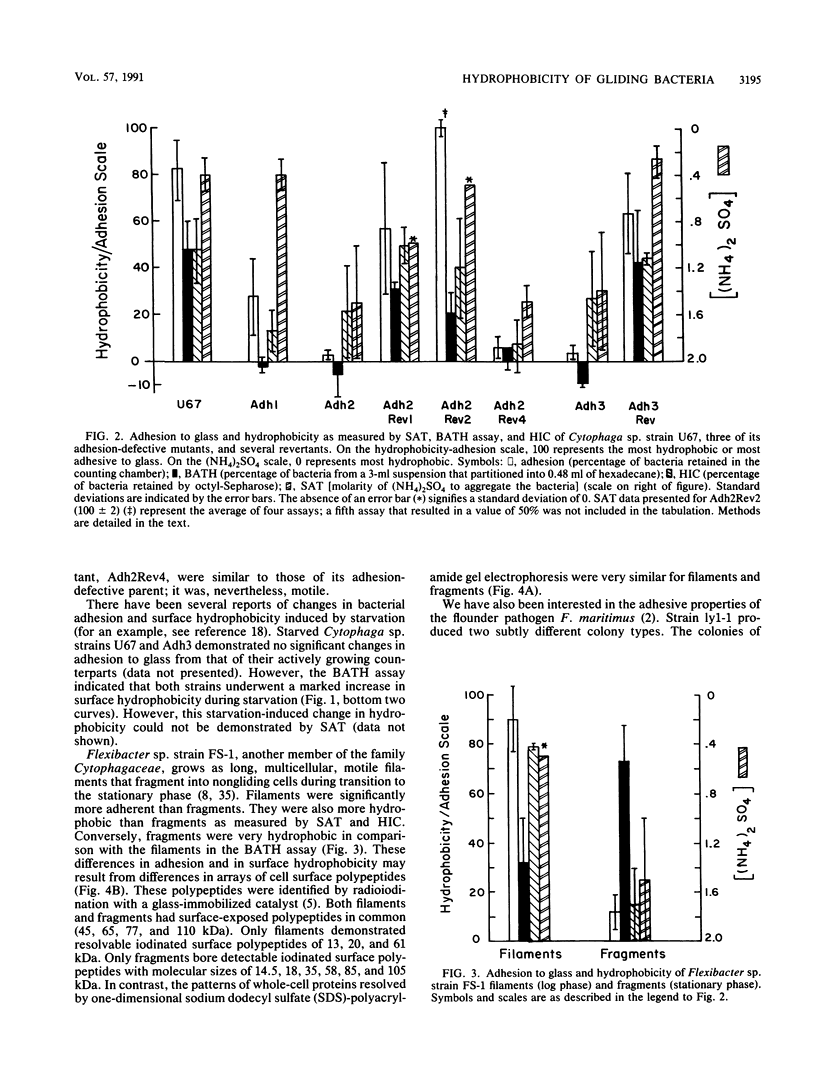
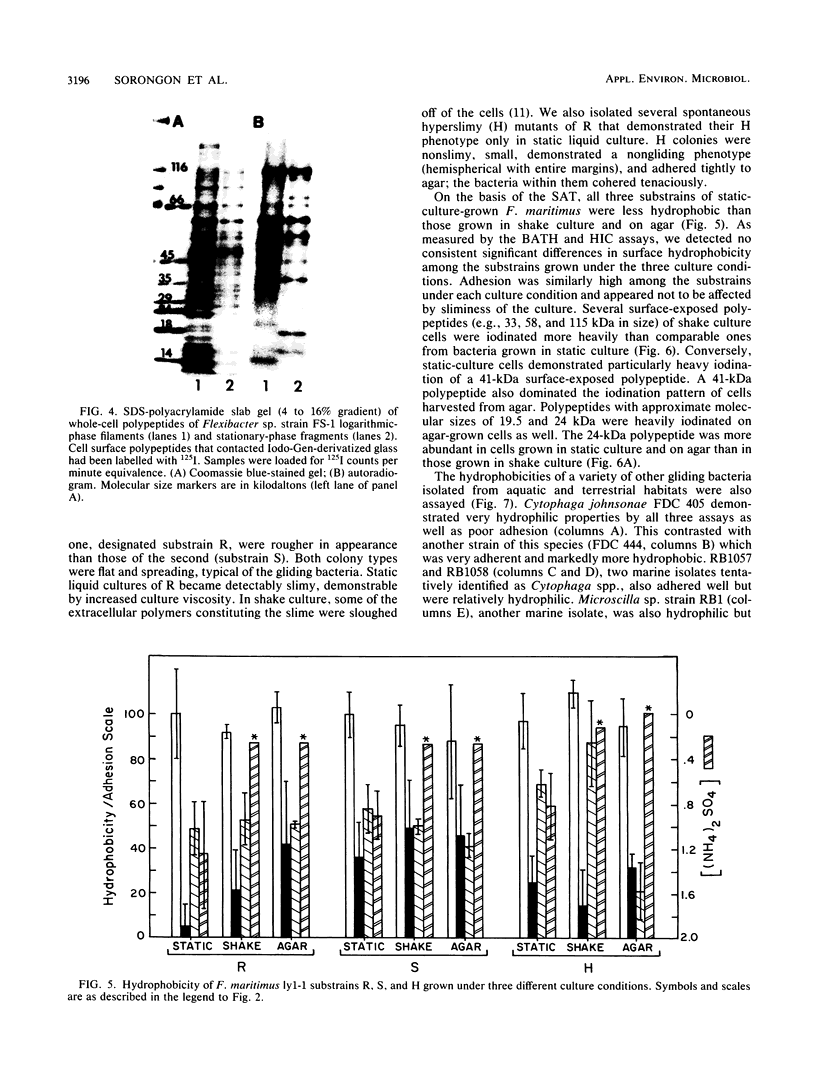
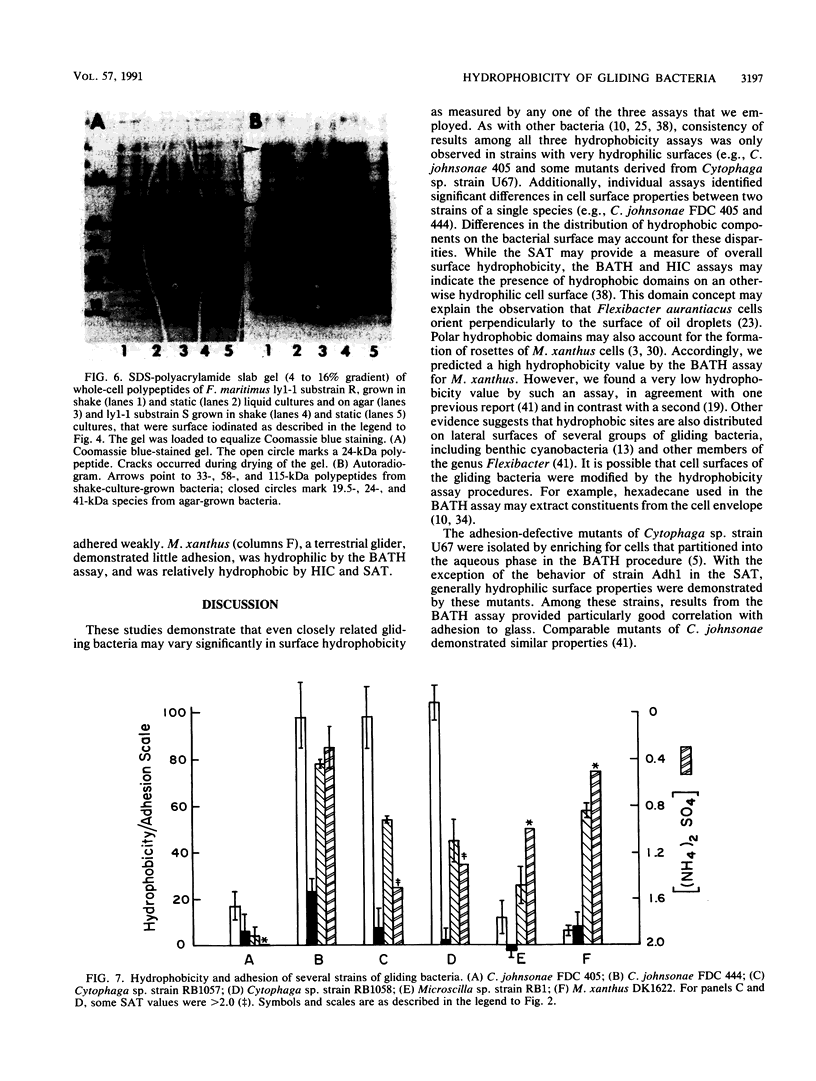
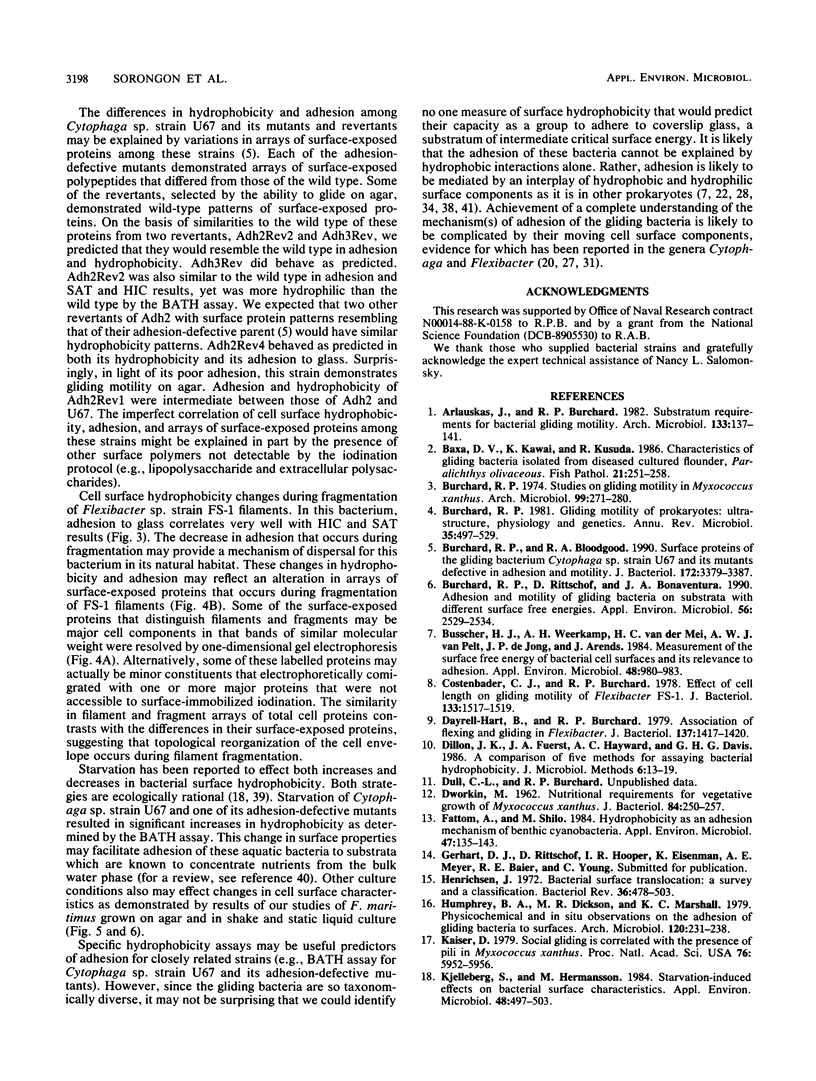
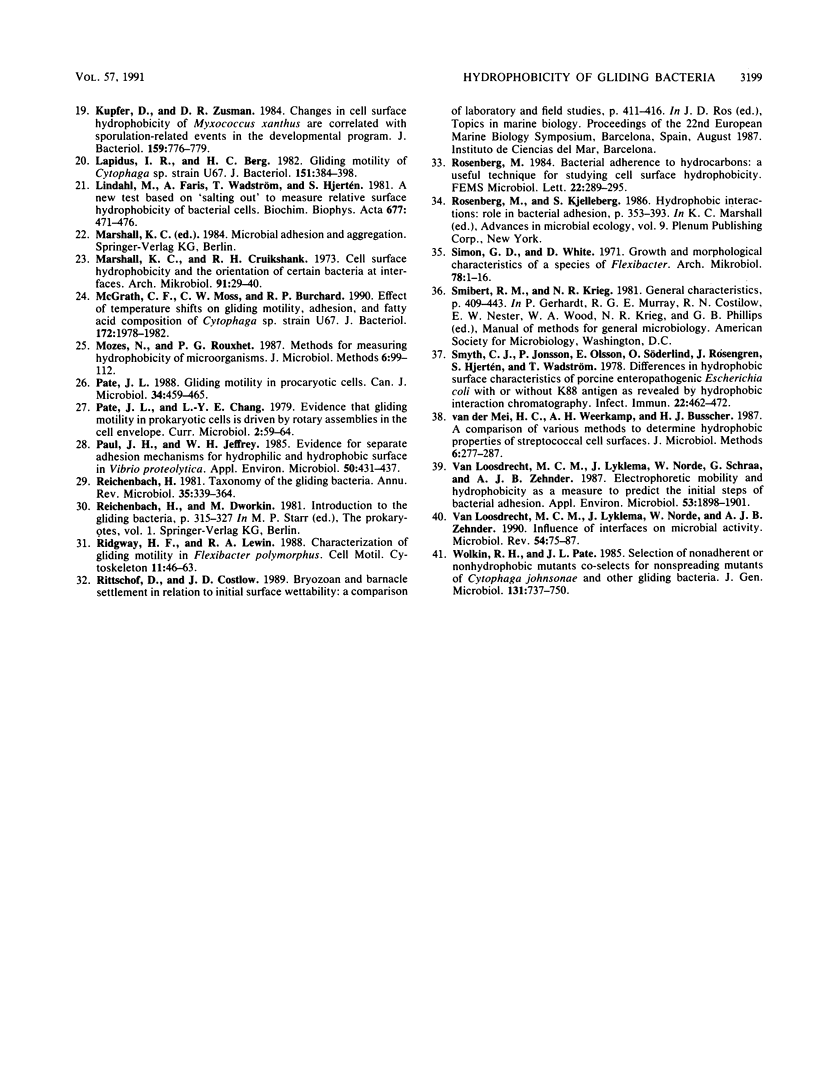
Images in this article
Selected References
These references are in PubMed. This may not be the complete list of references from this article.
- Burchard R. P., Bloodgood R. A. Surface proteins of the gliding bacterium Cytophaga sp. strain U67 and its mutants defective in adhesion and motility. J Bacteriol. 1990 Jun;172(6):3379–3387. doi: 10.1128/jb.172.6.3379-3387.1990. [DOI] [PMC free article] [PubMed] [Google Scholar]
- Burchard R. P. Gliding motility of prokaryotes: ultrastructure, physiology, and genetics. Annu Rev Microbiol. 1981;35:497–529. doi: 10.1146/annurev.mi.35.100181.002433. [DOI] [PubMed] [Google Scholar]
- Burchard R. P., Rittschof D., Bonaventura J. Adhesion and motility of gliding bacteria on substrata with different surface free energies. Appl Environ Microbiol. 1990 Aug;56(8):2529–2534. doi: 10.1128/aem.56.8.2529-2534.1990. [DOI] [PMC free article] [PubMed] [Google Scholar]
- Burchard R. P. Studies on gliding motility in Myxococcus xanthus. Arch Microbiol. 1974;99(3):271–280. doi: 10.1007/BF00696242. [DOI] [PubMed] [Google Scholar]
- Busscher H. J., Weerkamp A. H., van der Mei H. C., van Pelt A. W., de Jong H. P., Arends J. Measurement of the surface free energy of bacterial cell surfaces and its relevance for adhesion. Appl Environ Microbiol. 1984 Nov;48(5):980–983. doi: 10.1128/aem.48.5.980-983.1984. [DOI] [PMC free article] [PubMed] [Google Scholar]
- Costenbader C. J., Burchard R. P. Effect of cell length on gliding motility of Flexibacter. J Bacteriol. 1978 Mar;133(3):1517–1519. doi: 10.1128/jb.133.3.1517-1519.1978. [DOI] [PMC free article] [PubMed] [Google Scholar]
- DWORKIN M. Nutritional requirements for vegetative growth of Myxococcus xanthus. J Bacteriol. 1962 Aug;84:250–257. doi: 10.1128/jb.84.2.250-257.1962. [DOI] [PMC free article] [PubMed] [Google Scholar]
- Davis B. How to start or improve your public relations program--without a large budget. Hosp Top. 1986 May-Jun;64(3):10-3, 19. doi: 10.1080/00185868.1986.9952434. [DOI] [PubMed] [Google Scholar]
- Dayrell-Hart B., Burchard R. P. Association of flexing and gliding in Flexibacter. J Bacteriol. 1979 Mar;137(3):1417–1420. doi: 10.1128/jb.137.3.1417-1420.1979. [DOI] [PMC free article] [PubMed] [Google Scholar]
- Fattom A., Shilo M. Hydrophobicity as an adhesion mechanism of benthic cyanobacteria. Appl Environ Microbiol. 1984 Jan;47(1):135–143. doi: 10.1128/aem.47.1.135-143.1984. [DOI] [PMC free article] [PubMed] [Google Scholar]
- Henrichsen J. Bacterial surface translocation: a survey and a classification. Bacteriol Rev. 1972 Dec;36(4):478–503. doi: 10.1128/br.36.4.478-503.1972. [DOI] [PMC free article] [PubMed] [Google Scholar]
- Kaiser D. Social gliding is correlated with the presence of pili in Myxococcus xanthus. Proc Natl Acad Sci U S A. 1979 Nov;76(11):5952–5956. doi: 10.1073/pnas.76.11.5952. [DOI] [PMC free article] [PubMed] [Google Scholar]
- Kjelleberg S., Hermansson M. Starvation-induced effects on bacterial surface characteristics. Appl Environ Microbiol. 1984 Sep;48(3):497–503. doi: 10.1128/aem.48.3.497-503.1984. [DOI] [PMC free article] [PubMed] [Google Scholar]
- Kupfer D., Zusman D. R. Changes in cell surface hydrophobicity of Myxococcus xanthus are correlated with sporulation-related events in the developmental program. J Bacteriol. 1984 Aug;159(2):776–779. doi: 10.1128/jb.159.2.776-779.1984. [DOI] [PMC free article] [PubMed] [Google Scholar]
- Lapidus I. R., Berg H. C. Gliding motility of Cytophaga sp. strain U67. J Bacteriol. 1982 Jul;151(1):384–398. doi: 10.1128/jb.151.1.384-398.1982. [DOI] [PMC free article] [PubMed] [Google Scholar]
- Lindahl M., Faris A., Wadström T., Hjertén S. A new test based on 'salting out' to measure relative surface hydrophobicity of bacterial cells. Biochim Biophys Acta. 1981 Nov 5;677(3-4):471–476. doi: 10.1016/0304-4165(81)90261-0. [DOI] [PubMed] [Google Scholar]
- Marshall K. C., Cruickshank R. H. Cell surface hydrophobicity and the orientation of certain bacteria at interfaces. Arch Mikrobiol. 1973 Apr 8;91(1):29–40. doi: 10.1007/BF00409536. [DOI] [PubMed] [Google Scholar]
- McGrath C. F., Moss C. W., Burchard R. P. Effect of temperature shifts on gliding motility, adhesion, and fatty acid composition of Cytophaga sp. strain U67. J Bacteriol. 1990 Apr;172(4):1978–1982. doi: 10.1128/jb.172.4.1978-1982.1990. [DOI] [PMC free article] [PubMed] [Google Scholar]
- Paul J. H., Jeffrey W. H. Evidence for Separate Adhesion Mechanisms for Hydrophilic and Hydrophobic Surfaces in Vibrio proteolytica. Appl Environ Microbiol. 1985 Aug;50(2):431–437. doi: 10.1128/aem.50.2.431-437.1985. [DOI] [PMC free article] [PubMed] [Google Scholar]
- Reichenbach H. Taxonomy of the gliding bacteria. Annu Rev Microbiol. 1981;35:339–364. doi: 10.1146/annurev.mi.35.100181.002011. [DOI] [PubMed] [Google Scholar]
- Ridgway H. F., Lewin R. A. Characterization of gliding motility in Flexibacter polymorphus. Cell Motil Cytoskeleton. 1988;11(1):46–63. doi: 10.1002/cm.970110106. [DOI] [PubMed] [Google Scholar]
- Simon G. D., White D. Growth and morphological characteristics of a species of Flexibacter. Arch Mikrobiol. 1971;78(1):1–16. doi: 10.1007/BF00409084. [DOI] [PubMed] [Google Scholar]
- Smyth C. J., Jonsson P., Olsson E., Soderlind O., Rosengren J., Hjertén S., Wadström T. Differences in hydrophobic surface characteristics of porcine enteropathogenic Escherichia coli with or without K88 antigen as revealed by hydrophobic interaction chromatography. Infect Immun. 1978 Nov;22(2):462–472. doi: 10.1128/iai.22.2.462-472.1978. [DOI] [PMC free article] [PubMed] [Google Scholar]
- van Loosdrecht M. C., Lyklema J., Norde W., Schraa G., Zehnder A. J. Electrophoretic mobility and hydrophobicity as a measured to predict the initial steps of bacterial adhesion. Appl Environ Microbiol. 1987 Aug;53(8):1898–1901. doi: 10.1128/aem.53.8.1898-1901.1987. [DOI] [PMC free article] [PubMed] [Google Scholar]
- van Loosdrecht M. C., Lyklema J., Norde W., Zehnder A. J. Influence of interfaces on microbial activity. Microbiol Rev. 1990 Mar;54(1):75–87. doi: 10.1128/mr.54.1.75-87.1990. [DOI] [PMC free article] [PubMed] [Google Scholar]




